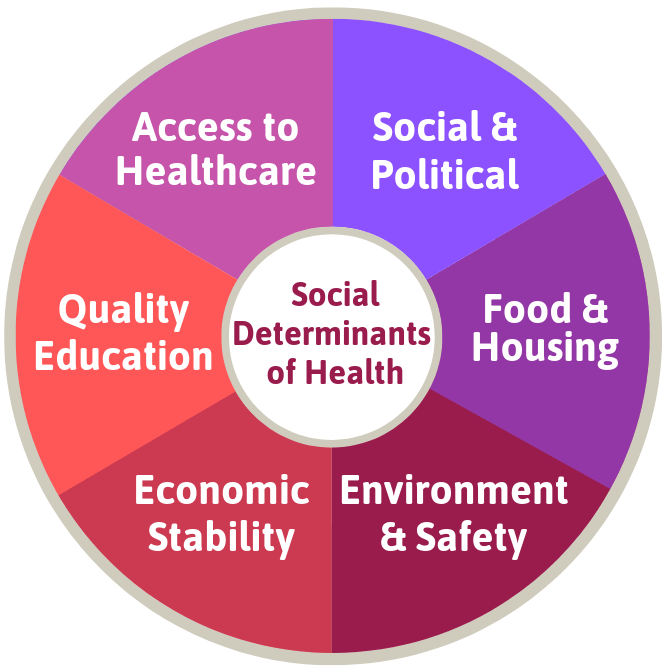Social Determinants of Health (SDOH) are the conditions in which people are born, live, work and interact with their environment that impact their health.¹ These areas can include, but are not limited to the location of health services, neighborhood safety, home-life, political environment, school systems, transportation services, work routine and available grocery stores and markets. All these factors contribute to a patient’s community.²

SDOH data improves patient care by allowing care providers to address the outside health factors that contribute to overall well-being.

SDOH are just as important as clinical data because it provides an insight into resource gaps in the community. For example, two men with the same condition and age may look the same, but their treatments may be completely different when SDOH are taken into account. One male may have high income, an education and live in a safe environment that allows him to properly care for his condition. While the other male may live in poverty, work a lesser paying job and be unsafe in his neighborhood. The second male may need outside help and interventions to ensure positive health. Social data allows care providers to make informative decisions about a patient’s overall health and to create treatment plans to ensure well-being outside of the clinic.
Not only is SDOH data accurate to needed clinical care, but it is also critical to lowering health care costs. Currently, the US spends over $52 billion annually on readmission costs.⁴ SDOH can help determine which patients are more likely to be readmitted due to health behaviors and the environment or lack of transportation to attain medications. By understanding these factors on the front end, providers can work to decrease readmission rates.³
Social Determinants of Health prove that there is more to health than the actions taken inside a doctor’s office.
CARE GAP: A patient’s social networks, environment, and economic conditions have just as much impact on their health as physical factors that can be examined by a physician. In order to properly care for a patient, treatments must positively impact their knowledge, attitudes, and motivations, as well as their physical health in a cost-effective manner. Without full understanding of a patient’s social determinants of health, treatment is limited.
CERTINTELL SOLUTION: Telehealth breaks down barriers of SDOH with their services and accommodations. Certintell connects patients to providers virtually using internet-connected devices. This is beneficial to underserved populations in particular because it gives many people access to care who would not otherwise get it. By using telehealth solutions, patients can see doctors through a screen, so they do not have to physically go to a clinic. This reduces appointment costs and eliminates transportation expenses. It also saves everyone time. Certintell strives to close gaps in health care by delivering services to everyone regardless of their social determinants.
GET ACTIVE
➠ Explore how programs, practices, and policies in these areas affect the health of individuals, families, and communities. Learn what affects your health and work to promote a healthier lifestyle.
➠ Take action with PREPARE Implementation and Action Toolkit. Discover your assets, risks and experiences with this toolkit.
¹ “Social Determinants of Health | Healthy People 2020.” 9 July 2019, www.healthypeople.gov/2020/topics-objectives/topic/social-determinants-of-health.
² “Beyond Health Care: The Role of Social Determinants in Promoting Health and Health Equity.” Henry J. Kaiser Family Foundation, 10 May. 2018, www.kff.org/disparities-policy/issue-brief/beyond-health-care-the-role-of-social-determinants-in-promoting-health-and-health-equity.
³ “Three Keys to Success with Social Determinants: Motivation, Myths and Management.” LexisNexis Risk Solutions, October. 2019, Webinar.
⁴ Beauvais, B., Whitaker, Z., Kim, F., & Anderson, B. “Is the Hospital Value-Based Purchasing Program Associated with Reduced Hospital Readmissions?” Journal of Multidisciplinary Healthcare, Volume 15, 1089–1099. 12 May 2022, https://doi.org/10.2147/jmdh.s358733
EDITOR’S NOTE: This article was first featured as a part of Certintell’s 2019 National Health Center Week efforts to support the awareness, advocacy and celebration of Community Health Centers during the annual weeklong event. The original content has been expanded to provide more value to the reader.
